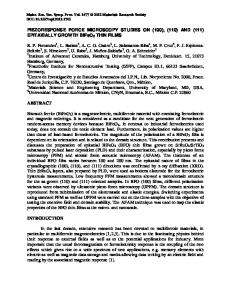Mechanism for enhanced ferroelectricity in multi-doped BiFeO 3 thin films
- PDF / 1,901,601 Bytes
- 13 Pages / 595.276 x 790.866 pts Page_size
- 52 Downloads / 900 Views
Mechanism for enhanced ferroelectricity in multi-doped BiFeO3 thin films Xixi Ren1, Guoqiang Tan1,* Ao Xia1, and Wenlong Liu3
, Jincheng Li1, Yun Liu1, Mintao Xue1, Huijun Ren2,
1
Shaanxi Key Laboratory of Green Preparation and Functionalization for Inorganic Materials, School of Materials Science and Engineering, Shaanxi University of Science and Technology, Xi’an 710021, Shaanxi, China 2 School of Arts and Sciences, Shaanxi University of Science and Technology, Xi’an 710021, Shaanxi, China 3 School of Electronic Information and Artificial Intelligence, Shaanxi University of Science and Technology, Xi’an 710021, Shaanxi, China
Received: 16 July 2020
ABSTRACT
Accepted: 15 November 2020
The thin films of BFO, binary-doped Bi0.96Sr0.04Fe0.98Co0.02O3, and multi-doped Bi0.96Sr0.04Fe0.94Mn0.04Co0.02O3 are fabricated using the sol–gel method. To study the mechanism for the enhanced intrinsic ferroelectricity in multi-doped BFO, this work uses related aspects including the electrostatic potential energy, the Fermi level, and the Schottky interface barrier. Using multi-doped BFO can reduce the height of the electrostatic barrier and change the Fermi level so that the Schottky barrier height is increased to reduce the leakage current, thereby improving the intrinsic ferroelectricity. Also, using multivalent Mn with a double-exchange effect improves the ferromagnetism. These improved intrinsic ferroelectric and ferromagnetic properties make BFO applicable in various practical devices and fields.
Ó
Springer Science+Business
Media, LLC, part of Springer Nature 2020
1 Introduction Multifunctional materials that have multiferroic properties have received extensive attention recently for the preparation and application of memory devices [1–3], spintronic devices [4], and resistance switching diodes [5]. But the volatilization of Bi3? and the transformation of Fe3? to Fe2? lead to the formation of defects such as vacancies in the thin film, so that the pure phase BFO has a large leakage current and very low residual polarization value.
Address correspondence to E-mail: [email protected]
https://doi.org/10.1007/s10854-020-04900-8
Therefore, an urgent task is to improve the multiferroic properties of BFO and apply it directly to modern equipment and devices. To date, overcoming the issue of the weak multiferroic properties of BFO has led to the adoption of doping [6], recombination [7–9], and other methods. Doping has generally been divided into doping at A sites (such as rare-earth elements [10–16]), doping at B sites (such as transition metals and alkaline earth metal elements [6, 16–20]), and binary doping at A and B sites [13, 21–24]. The doping of rare-earth elements at A sites uses differences in the ionic radii to
J Mater Sci: Mater Electron
produce structural distortion in the crystal lattice, which may even form quasi-homogeneous phase boundaries [21] that are effective in improving the ferroelectricity of the thin film. Zheng et al. [11] prepared Er-doped BFO films using Er3? instead of Bi3?, which transforme
Data Loading...











